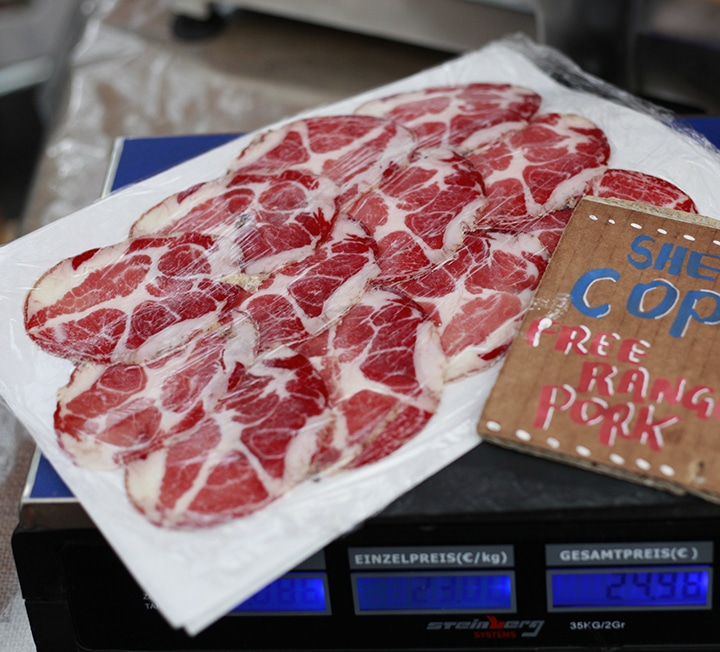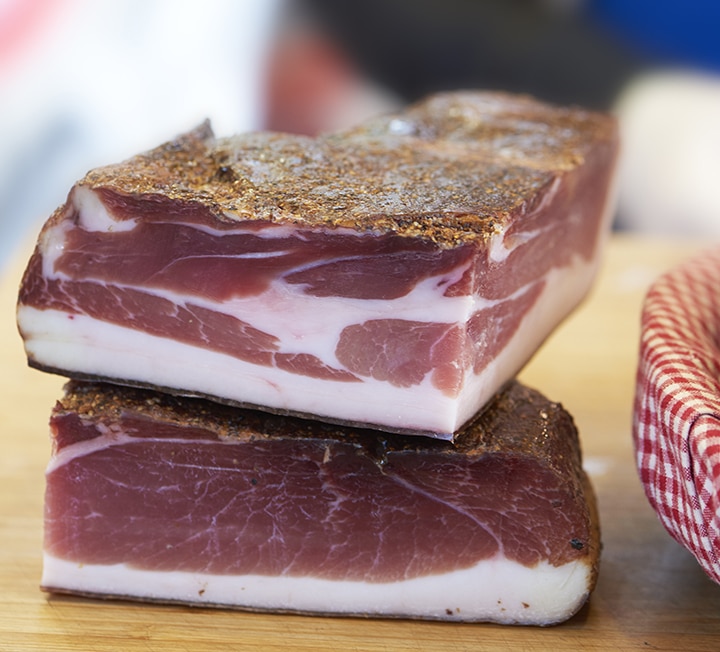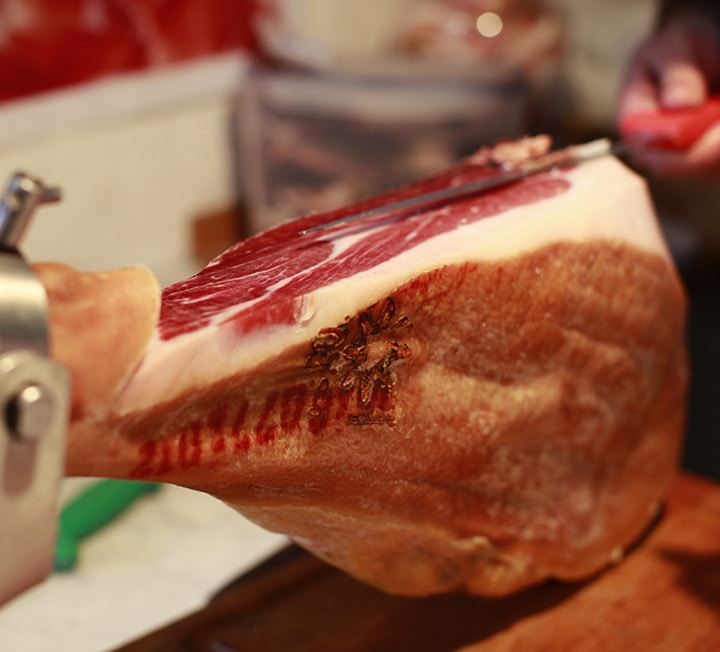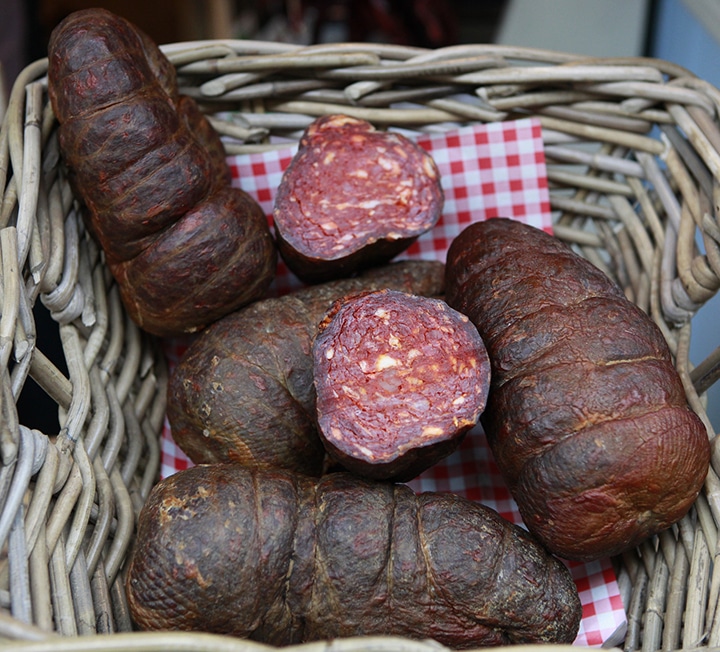Cut & dried: Italian salumi (part one)
Ed Smith explores the famous cured meats of Emilia-Romagna, Tuscany and Lombardy


“ITALY IS BLESSED WITH JUST THE RIGHT HUMIDITY, HEAT AND WIND FLOW TO AIR DRY MEAT”
Words: Ed Smith
In Britain, most of us refer to cured meat as ‘charcuterie’, which is the French word for meaty things (more on them in a few months’ time). In the context of European cuisine, however, there’s a strong argument that it’s the (Roman) Italians who originated, perfected and codified the craft of cured, air-dried meats – and so perhaps we should refer to sliced hams, belly meats, back fat and sausages as they do: ‘salumi’.
I once spoke with a British charcutier who said there wasn’t much he could learn from an Italian about curing because if he followed their instruction, leaving his meats to dry in caves set into the hills in Monmouthshire, he’d end up with mouldy meat. Italians in the belt of northern Italy that runs through Emilia-Romagna, Tuscany and Lombardy are, on the other hand, blessed with just the right humidity, heat and wind flow for the cuts of meat they cure with salt to be turned into delicious salumi.
Break it down
Italian butchery has evolved to ensure all parts of a pig can be cured. This is because the original purpose of curing was to preserve meat as a protein source in times when refrigeration and freezing were not an option. Whereas traditional English and American butchers would remove the shoulder of a pig, Italians ‘harvest’ a muscle known as the ‘coppa’ or ‘capocollo’ from the top of the neck so it can be cured in one cylindrical piece, rather than slicing through it.
Other defined parts of a pig – the loin, belly, and the back leg or ham – are separated for curing into ‘lonza’, ‘pancetta’, and ‘prosciutto’ (though in Zibello in Emilia Romagna, the ham is separated into ‘culatello’ and ‘fiocco’ as the air is too humid to successfully cure a whole leg). The remainder, including much of the fat, is minced to make sausages, known as ‘salami’.
At a very basic level, that’s it: a pig is broken down into its constituent parts, salted, fermented and air dried over a period of time, and you end up with either a muscle meat or a salami to slice.
Variety comes from the breed of the pig, its diet, the terroir and atmosphere of the relevant area. Indeed, in Italy, many (most?) meats are labelled to reflect either the specific regionality of the product (IGP – Indication of Geographic Protection) or that the salumi has been produced, processed and packaged in a specific geographical zone and according to tradition (DOP – Protected Designation of Origin).
The legs
A good example of how the same cut of meat can be a different product depending on regional variations is Italian cured ham, or ‘prosciutto’. You can explore this in real time at Borough Market by comparing prosciutto di Parma and prosciutto di San Daniele at The Parma Ham and Mozzarella Stand.
Parma ham, from Emilia-Romagna, is the highest profile air dried Italian meat. Though it is ultimately sliced into thin sheets, you will see it at the stall, hung still in its guitar-shaped thigh form. The legs are salted, then larded and hung to dry for up to 18 months. As a result, the flavour is deep, nutty, salty, slightly musty, and there’s masses of umami.
Though there are stipulations as to where pigs used to make Parma ham must be farmed, not all Parma ham is created equal. As owner Philip Crouch explained to me, one crucial difference is that the top, reserve-grade producers get first choice of the hams after slaughter, choosing them on the basis of age, fat ratio and size. Industrial-grade Parma hams are often made from pork that has been frozen, which seems to yield a lesser quality product. From Philip’s experience, it’s important for an importer to have a good relationship with the producer, and over time build a trust that ensures a consistently high-quality product.
An alternative is prosciutto di San Daniele. It’s the same piece of meat, but Italians will tell you that the taste is very different: sweeter, softer, more delicate. Perhaps because the drying (or maturation) time is shorter – around 13 months. Though the pigs can be from one of 10 regions, the ultimate production of the hams must be within a relatively small area in the commune of Friuli in Udine, northwest Italy. It has a unique microclimate which is influenced, it is suggested, by salty winds blown in from the Adriatic. Philip’s producer’s family has been producing the meat for hundreds of years, and “there’s an alchemy and experience and skill that they have in spades” that comes through in the eating experience.
Don’t take the tasting notes as definitive, though – try them both for yourself when next at Borough Market.
The fatty bits
Fat is a vital component of cured meats. Think of the marbling running through a piece of coppa (or jamon Iberico, for that matter); of the chunks of varying proportions distributed through salami, or of that ribbon of fat running over the top of a silk sheet of prosciutto ham or loin. Those bits are not there as something to be torn off and left on the edge of the plate. They provide a luscious texture, carry and enhance the qualities of the meats round your mouth, and have a flavour all of their own.
With that in mind, perhaps it shouldn’t be a surprise that there’s a whole genre of salume that’s basically just salted and cured fat. When it comes to lardo, guanciale, pancetta, and even pressed head (a brawn-like item called gelatina, coppa di testa and soppressata, depending where you are in Italy), fat is not the supporting act but the star.
The king of this genre is lardo di Colonnata: blocks of back fat taken from above the loin, salted and laid for months in marble boxes in a Tuscan hamlet. Unless you’ve a slicer of your own, buy it in thin strips and keep it very cold. Remove the lardo from its paper while still cold, but then wait until it’s at room temperature to relish it as antipasti, as you would any other salume, or lay it over warm green vegetables, potatoes and so on to enjoy the best salty seasoning of them all.
Look out too for guanciale and (proper) pancetta. Contrary to once-popular belief, pancetta is not the same as bacon. Instead, the kind you’ll find at The Parma Ham and Mozzarella Stand and Gastronomica is fully cured and ready to eat (again, slice thinly), though you can cook with it if you wish. Alternatively, consider cooking with guanciale, created from the cheek of the pig – The Parma Ham and Mozzarella Stand has a couple of options, one of which is the base ingredient for a proper carbonara.
Other salumi stars available at the Market
— Salame finocchiona: a sausage of finely ground pork belly, black pepper, chianti and fennel seeds.
— Salame Toscana: a sausage of relatively coarsely ground pork and large cubes of back fat, plus black pepper and red wine, sometimes garlic too.
— Salame Milanese: finely ground pork shoulder, with flecks of fat obvious throughout. Often quite large, yielding wide slices.
— Mortadella: a large sausage made of finely ground pork meat, blended (or ‘emulsified’) with a specific ratio of fat and spices, and cooked. True mortadella is from Bologna, the capital of Emilia-Romagna, and should be very thinly sliced.
— Coppa (or capocollo): a cylindrical muscle from the hard-working shoulders of a pig, so it’s dark and intensely flavoured, and marbled with intramuscular fat. Should be thinly sliced by machine. Coppa is a common cut across Italy – variation comes from the breed of pig and spicing in the cure. A number of IGP and DOPs exist, for example coppa di Piacentino and coppa di Parma, which must be made from pigs reared in those specific regions, be bagged in a pig or beef casting, and dried for at least 60 days.
— Lonza or lombo: cured pork loin (picture the larger part of back bacon or a pork chop). The leanest cut of salumi, though Italians leave a larger amount of back fat on the muscle than the Spanish do with their ‘lomo’. Must be sliced thinly.
— Pancetta: the belly of a pig. Can be left as one flat piece of fatty pork or rolled (‘arrotolata’). Often flavoured with lots of herbs and though it can be and often is cooked, in contrast to British bacon, pancetta is fully cured and if sliced thinly, ready to eat.
Where to shop for salumi from these regions at Borough Market
Bianca Mora has a concise selection of very pure and unadulterated cured pork from Emilia-Romagna; at Gastronomica you’ll find a wide spread of cured meats from across Italy (look out for their Tuscan finocchiona salami); The Parma Ham and Mozzarella Stand stocks all the classics, sliced to order.


